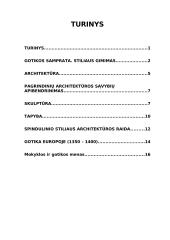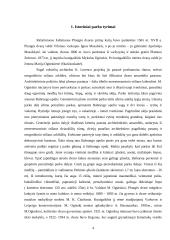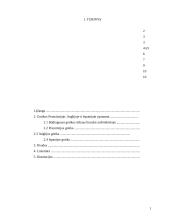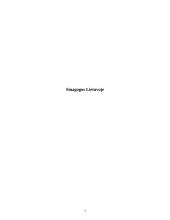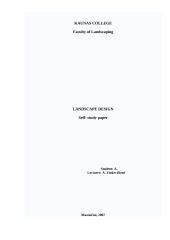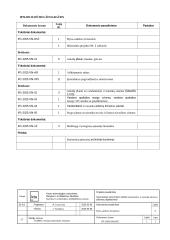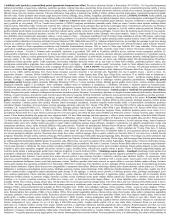Referatai
Russian avant-garde
INTRODUCTION The Bolshevik Revolution in 1917 radically reshaped Russia. At this time (1910-1920y.) was laid down fundament principles of abstract art and architecture. This view changed traditional conceptions of art and architecture. A new architecture was imagined to meet the pressing needs of a new society. Russia had a well-established architectural tradition, which rivaled that of the European early Soviet years. Russian architects had been moving toward a more rationalistic approach to architecture in the late 19th century, parallel to that in Europe. Russian avant-garde was divided at first into 2 movements: first of them Constructivism and second one - Rationalism. After some time appeared one more movement so called Supremantism. Two art institutes were established in 1920 in Moscow in the development of the Russia Avant-Garde after 1917: Inkhuk (Institute of Artistic Culture) and Vkhutemas (Hiher state Artistic and Technical studios). First of them was a research center of contemporary art directed by Wassily Kandinsky, and then by Rochenko. One of the main functions of the Inkhuk was to reduce the principal modern movements such as Supremantism and “the culture of materials” to a scientifically based program which could be used for educational and research purposes. The Vkhutemas, on the other hand, was an experimental and innovative art school as the Bauhaus. As a result of all this, architectural disputes no longer took place between traditionalists exclusively, but started to focus on differences in opinions within the modern architecture movement as a whole. Although Russia’s modern artists were predominantly nationalistically orientated, they kept an open mind on new developments abroad. This situation continued until the start of First World War stopped all contacts with foreign countries. This period of experimentation came to an end with the competition for the Palace of the Soviets in 1931. There were numerous entries including a highly evocative one by Le Corbusier, but the winning design was a Neo-Classical monument to pomp and circumstance, by Boris Iofan, which ushered in the new age of Stalinism. The Soviet avant-garde broke apart, with many of its leading members fleeing to Europe to escape the severity of this regime. RATIONALISTS The focus of a Rationalist architecture became Obmas (United Architectural Studios). It was led by the influential teacher Nikolai Ladovsky in 1923.Landovsky's Rationalism was based on theories of psychology rather than the more familiar form-follows-function rationalism of use, structure, and materials. He wanted to find scientific methods applicable to design, and believed it should be possible to measure the psychological effect of architecture on the viewer. In 1923-1932 ASNOVA [Assotsiatsiya Novykh Arkhitektorov; Rus.: Association of New Architects] was founded - a group of architects led by formalists (rationalists) NIKOLAY LADOVSKY, VLADIMIR KRINSKY and NIKOLAY DOKUCHAYEV. It was the USSR’s first avant-garde architectural association. Asnova intended to serve the new Soviet regime by establishing an architectural language based on economic and psychological efficiency. This Rationalist approach also attempted to secure an irrefutable, scientific foundation for the aesthetics of modern architecture. Ladovsky, Nikolay (Aleksandrovich) ( 1881-1941). Russian theorist, architect, urban planner and teacher. His principal contribution to Soviet architecture was the creation of the theoretical basis of Rationalism, which (with Constructivism) formed one of the two main Modernist movements in early Soviet architecture and urbanism. As a leading figure in the creation and organization of the Basic Course at the VKHUTEMAS, Moscow, through which all new students passed, Ladovsky was a particularly influential figure in the Russian avant-garde during the 1920s. Ladovsky's Teaching Method: 1. use creative imagination to generate innovative architectural ideas. 2. develop an understanding of space and shape. The Rationalists approach form in terms of the objective laws of perception. Basic factors governing the generation of form: (in order) SPACE -FORM - CONSTRUCTION. "The taste of design involves more than a mere external reflection of its internal purpose; it also involves the creation of an image. The new architecture would be marked by the use of simple solid forms, and therefore methods need to be evolved whereby the geometrical characteristics of each solid could be hightlighted by architectural means. The architect should be able to stimulate the spectator's imagination through the conjunction of clearly intelligible forms." Vladimir Feodorovich KRINSKY (1890-1971) Rationalism: The Scientific Discipline is to Think in Space The theory of abstract form is for consideration as a discipline of spatial thinking and points to the way of solving real problems. Construction - in the sense of the configuration of a building - incorporates material. I regard a well-defined construction as one that involves the configuration as a whole, while the combination and arrangement of supports represents composition. The construction and direction of forces, on the other hand, represents construction. The constructive principle can be traced in composition as the essence of design. In painting, composition lies along the path to the liberation from representation and turns to construction for the basic answer: that is why it is difficult to separate composition from construction in painting (and sculpture). In architecture, construction present a technical and mechanical basis - the very basis of composition. Construction implies a movement of force, or a direction, which is schematically expressed by lines... 'Form is an invention, not a cult. Its value is proved in action.' Living Architecture consists of creating the present. And the architect has one weapon in his creative art -form... Our understanding of form depends upon some of its particular qualities... Line, plane and geometrical surface are eternel. They represent the laws of our thought in perception... The problem of perception of form in architecture, sculpture and painting comes down to a perception of space. The aim of abstract form is purely theoretical. It is the theory of form in generalized terms. The scientific discipline is to think in space. One cannot apply abstract form to reality, or utilize it. A cube, a cylinder or a cone are not forms, but concepts by means of which we resolve a given form. 'Form is an invention, not a cult. Its value is proved in action.' Dokuchayev, Nikolay (Vasil’yevich) (1891-1944). Russian architect, urban planner, theorist and teacher. He graduated from the College of Painting, Sculpture and Architecture, Moscow, in 1916, and took a further year’s course at the Academy of Arts in Petrograd (now St Petersburg). Returning to Moscow after the Revolution, he worked from 1918 to 1924 in the Mossoviet architectural studio, headed by Aleksey Shchusev, on the first plan for reconstructing Moscow as the Soviet capital. In the same period he began teaching at his former school, which was formed initially into the State Free Art Studios (Rus. Svomas) and, from 1920, the VKHUTEMAS. During 1921 he became involved in the formal and spatial researches of the six-man Working Group of Architects of INKHUK (Rus.: Institute of artistic culture), Moscow. With two of his colleagues in the group, Nikolay Ladovsky and Vladimir Krinsky, who were fellow teachers, he devised curricula for the Vkhutemas, firstly that of the school’s General Studio, set up in opposition to historicists, and then of the Basic Course through which all new students of the institute passed. "Architecture should cease to be anarchy of individualistic tastes, interpretations and feelings, it should become scientific value, which had distinctly found out its laws of composition and constructive principles of organization of architectonic forms and space (similarly to an art of music). These basements of architecture must distinctly combine both formal, and social-ideological and material sides, from which each architectonic form is composed. For this purpose the architectural education should be widely put, concerning its attitude towards the study of social-economic and technical disciplines, as well as art disciplines, based on biological and physiological principles of our perception of the visible
Šį darbą sudaro 3994 žodžiai, tikrai rasi tai, ko ieškai!
★ Klientai rekomenduoja
Šį rašto darbą rekomenduoja mūsų klientai. Ką tai reiškia?
Mūsų svetainėje pateikiama dešimtys tūkstančių skirtingų rašto darbų, kuriuos įkėlė daugybė moksleivių ir studentų su skirtingais gabumais. Būtent šis rašto darbas yra patikrintas specialistų ir rekomenduojamas kitų klientų, kurie po atsisiuntimo įvertino šį mokslo darbą teigiamai. Todėl galite būti tikri, kad šis pasirinkimas geriausias!
Norint atsisiųsti šį darbą spausk ☞ Peržiūrėti darbą mygtuką!
- Architektūros referatas
- 12 psl., (3994 ž.)
- Word failas 872 KB
- Lygis: Universitetinis
- ✅ Yra šaltiniai
Mūsų mokslo darbų bazėje yra daugybė įvairių mokslo darbų, todėl tikrai atrasi sau tinkamą!
Kiti darbai
Privalumai
Atsisiuntei rašto darbą ir neradai jame reikalingos informacijos? Pakeisime jį kitu nemokamai.
Pirkdamas daugiau nei vieną darbą, nuo sekančių darbų gausi 25% nuolaidą.
Išsirink norimus rašto darbus ir gauk juos akimirksniu po sėkmingo apmokėjimo!
Atsiliepimai



















